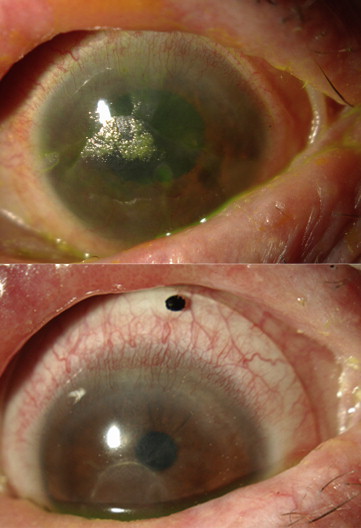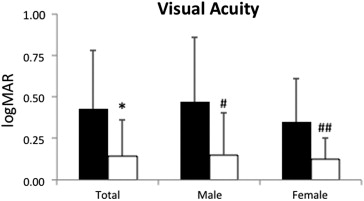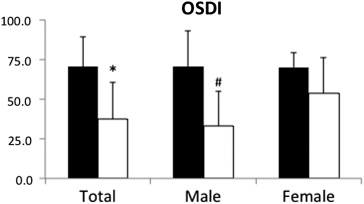Purpose
To evaluate the results of Prosthetic Replacement of the Ocular Surface Ecosystem (PROSE) scleral lens treatment on visual acuity and function in patients with ocular symptoms of chronic Stevens-Johnson syndrome (SJS).
Design
Retrospective interventional case series.
Methods
setting : Single multi-specialty institutional practice. study population : A chart review from July 2009 to July 2013 identified 19 patients with ocular symptoms from chronic SJS who were referred for PROSE fitting evaluation. Three patients deemed appropriate candidates were excluded because they were lost to follow-up during the fitting process. Only 1 eye was fitted in 4 patients because anatomic changes prohibited PROSE fitting in the fellow eye. Another patient chose to have PROSE fitting only in 1 eye. A total of 27 eyes of 16 patients who completed PROSE fitting were included in this study. intervention : PROSE scleral lens fitting. outcome measures : Visual acuity and visual function were assessed before and after PROSE fitting using Snellen acuity and Ocular Surface Disease Index (OSDI) survey. The OSDI survey is a validated questionnaire that assesses ocular surface disease in the context of vision-related function, ocular symptoms, and environmental triggers.
Results
Visual acuity improved from 0.43 ± 0.35 logMAR pre-PROSE to 0.14 ± 0.22 logMAR post-PROSE ( P = .0007) in SJS patients. OSDI scores improved from 70.4 ± 19.0 pre-PROSE to 37.4 ± 23.2 post-PROSE ( P = .0002) in the same cohort.
Conclusion
The results of this study show that PROSE treatment is a viable option for improving visual acuity and function in SJS patients who failed conventional treatment.
Stevens-Johnson syndrome (SJS) and the more severe toxic epidermal necrolysis (TEN) are forms of hypersensitivity reactions that lead to blistering of skin and mucous membranes. Ocular involvement from SJS and TEN leads to cicatrization of the ocular surface, which results in pain and impaired vision that can be debilitating and frustrating for the patient. In the acute phase of SJS, ocular manifestations can range from a mild conjunctivitis to sloughing of large areas of conjunctiva. Management of the initial phase is geared toward controlling ocular surface inflammation that can rapidly progress to conjunctival sloughing. This can be accomplished using a variety to medical therapies, such as topical corticosteroids, and surgical procedures, including amniotic membrane transplantation. The use of systemic corticosteroids in SJS remains controversial. Although early recognition and intervention can minimize the ocular sequelae of chronic SJS, a majority of patients experience some degree of ocular surface cicatrization and a significant portion of these patients suffer debilitating consequences.
Signs of ocular surface cicatrization can range from mild subconjunctival fibrosis to symblepharon formation and forniceal foreshortening with conjunctivalization of the corneal surface. Patients can experience foreign body sensation and pain from these changes, and those with changes to the cornea can also experience vision loss attributable to compromised corneal transparency. Chronic ocular changes also lead to limbal stem cell deficiency, making patients with vision loss from corneal changes poor candidates for corneal transplantation. Permanent keratoprosthesis is a feasible option for patients with severe vision loss, but long-term postoperative morbidity has tempered the initial enthusiasm for implantation of permanent keratoprosthesis. Examples of postoperative morbidity in SJS patients include sterile inflammation, carrier tissue melt leading to aqueous leak, skin retraction, formation of retroprosthetic membranes, and vision loss attributable to glaucoma. The outcome of keratoprosthesis implantation in SJS patients was noted to be substantially inferior to those in nonautoimmune conditions in the previously cited study. Fortunately for many patients with chronic ocular manifestations of SJS, conventional treatments, such as artificial tears, soft contact lenses, and oral supplements, can provide sufficient improvements in visual acuity and function. There is, however, a subgroup of patients who do not get satisfactory relief from conventional treatments.
Prosthetic Replacement of the Ocular Surface Ecosystem (PROSE) treatment (Boston Foundation for Sight, Needham, Massachusetts, USA), uses a custom-designed scleral device that vaults the entire cornea and limbus and bathes it in a pool of nonpreserved sterile saline. The PROSE fitting process involves the use of a proprietary software program that allows for a highly customizable device that precisely fits the curvature of each patient’s eye to maximize vision and comfort. We hypothesized that PROSE scleral lenses would offer improvements in visual acuity and function for patients with chronic ocular manifestations of SJS who had failed conventional treatments. Several studies have previously shown that PROSE scleral lenses significantly improve visual acuity and functioning for patients with various ocular surface diseases. Prior to our study, the benefits of PROSE scleral lens therapy in SJS patients were evaluated in a limited number of studies, with outcomes based on visual acuity and clinical examination changes. The purpose of this study was to evaluate the results of our experience using PROSE scleral lenses for management of patients with ocular symptoms of chronic SJS who had failed conventional treatments, with outcomes based on visual acuity and function. To our knowledge, this study represents the largest group of SJS patients fitted with PROSE scleral lenses using visual function as an outcomes measure.
Methods
The University of Southern California (USC) Institutional Review Board retrospectively approved this retrospective interventional case series study at a single multi-specialty institutional practice. Visual acuity and visual function data were collected from charts of patients who consented for the use of their clinical data per Health Insurance Portability and Accountability Act guidelines.
A chart review of SJS patients with chronic ocular manifestations who had failed conventional treatments and were referred to the USC Eye Institute for PROSE fitting evaluation between July 1, 2009 and July 30, 2013 identified 19 patients. Three patients deemed appropriate candidates were excluded because they were lost to follow-up during the fitting process. Only 1 eye was fitted in 5 patients because 1 patient was status post-enucleation in the fellow eye, 1 patient chose not to proceed in the fellow eye owing to unsatisfactory vision improvement, 2 patients had clinical findings in their fellow eye (1 with extensive symblepharon and forniceal foreshortening and the other with permanent tarsorrhaphy) that made PROSE insertion prohibitively difficult, and 1 patient had minimal symptoms and chose not to proceed in the fellow eye. In total, data from 27 eyes of 16 patients were analyzed in this study.
Visual acuity (VA) was obtained before and after PROSE treatment using a Snellen chart under standardized illumination with the projected image calibrated for the length of the examination room. Pre-PROSE VA was obtained using either manifest refraction or the patient’s device at the time of initial evaluation. Post-PROSE VA was obtained at completion of the lens fitting. Visual acuities were then converted from Snellen acuity to logarithm of the minimal angle of resolution (logMAR) acuity for statistical analysis.
Visual function was assessed before and after PROSE fitting using the Ocular Surface Disease Index (OSDI), a validated 12-item questionnaire designed to grade severity of ocular surface disease in the context of vision-related function, ocular symptoms, and environmental triggers. Each item is scored on a scale of 0–4, and the final score is calculated by summing the individual scores of all questions answered × 100 divided by the total number of questions answered × 4. Pre-PROSE OSDI scores were obtained from the patient at the initial consultation visit, and post-PROSE OSDI scores were obtained at least 6 months after the last fitting visit via telephone by a trained interviewer masked to the patient’s clinical information. Fourteen of 16 total patients, 11 of 11 male and 3 of 5 female patients, completed the post-PROSE OSDI interview. One female patient could not be reached after moving out of the country and the other declined to participate for unspecified reasons.
For statistical analysis, all data sets were assumed to have a normal distribution. Thus, homoscedastic 2-tailed t tests were conducted to compare pre- and post-PROSE VA and OSDI scores using the statistical package in Excel 14.3.8, Microsoft, Redmond, Washington.
Results
Data from 27 eyes from 16 individuals with chronic ocular manifestations of SJS who completed PROSE treatment were analyzed in this retrospective study. There were 18 eyes of 11 male and 9 eyes of 5 female patients in our cohort, with a mean age of 40.3 ± 11.2 years at the time of PROSE fitting. Female patients were slightly younger than male patients, 37.8 ± 11.9 years vs 41.5 ± 11.3 years, at the time of PROSE fitting, but their ages were not significantly different ( P = .56). Ocular features of our patients with chronic manifestations of SJS included keratinization of the lid margins, subconjunctival fibrosis, symblepharon, and conjunctivalization of the corneal surface ( Figure 1 ). The PROSE device vaults the entire cornea and limbus and rests on the adjacent conjunctiva ( Figure 1 ).

The mean pre-PROSE VA of our SJS cohort was 0.43 ± 0.35 logMAR ( Figure 2 ). Male patients had a mean pre-PROSE VA of 0.47 ± 0.39 logMAR while female patients had a mean pre-PROSE VA of 0.35 ± 0.26 logMAR. There was no significant difference in pre-PROSE VA between male and female patients ( P = .41). The mean post-PROSE VA in our SJS cohort was 0.14 ± 0.22 logMAR, which represented a significant improvement over the pre-PROSE VA ( P = .0007). Male patients had a mean post-PROSE VA of 0.15 ± 0.25 logMAR and female patients had a mean post-PROSE VA of 0.13 ± 0.13 logMAR. While there was no significant difference in post-PROSE VA between male and female patients ( P = .77), each group showed significant improvements in VA following PROSE fitting ( P = .006 for male patients and P = .03 for female patients). In terms of Snellen acuities, the cohort improved from approximately 20/54 before to 20/28 after PROSE treatment.

Of the 16 patients in the study, 14 completed the post-PROSE OSDI survey. The mean pre-PROSE OSDI score of our SJS cohort was 70.4 ± 19.0 ( Figure 3 ). Male patients had a pre-PROSE OSDI score of 70.6 ± 22.5, while female patients had a score of 70.0 ± 9.2, indicating that there was no significant difference in pre-PROSE OSDI scores between male and female patients ( P = .96). The mean post-PROSE OSDI score of our SJS cohort was 37.4 ± 23.2, which represented a significant improvement ( P = .0002). Male patients had a mean post-PROSE OSDI score of 32.9 ± 22.2, and female patients had a score of 53.8 ± 22.4, indicating that there was no significant difference in post-PROSE OSDI scores between male and female patients ( P = .17). Male patients showed a significant improvement in OSDI scores before and after PROSE treatment ( P = .0008), while female patients did not show a statistically significant difference ( P = .19). In our cohort, 11 of 11 male patients and 3 of 5 female patients completed the post-PROSE OSDI interview. During the post-PROSE OSDI interview, patients were also asked whether they wore their PROSE devices all (100%), most (∼75%), half (∼50%), some (∼25%), or none (stopped PROSE wear) of their waking hours. Seven of 14 of the patients reported wearing their PROSE devices all of the time and 5 of 14 patients reported most of the time, while only 2 patients reported none of the time during the post-PROSE OSDI interview. One patient reported a change in lens fit that caused introduction of air underneath the device, and another patient reported sufficient improvement in symptoms making further PROSE wear unnecessary.





